Running one set of ducts for multiple bathroom fans makes practical sense. You don’t have to go to the trouble and expense of running two duct that will, in all likelihood, run parallel through house’s framework for the most part. And why make two holes in the roof where one will do?
The truth is that linking ventilation ducts is not something to be undertaken lightly. In some cases, such as with dryers, it is illegal. It is not illegal for bathroom fans, but there are certain considerations to assess before going forward.

Bathroom fans can share a common vent via a two-fan or one-fan (inline fan) method. Manufacturer instructions and professional recommendations must be considered (often agains sharing). Ducts and inline fans must be sized up. Fans in the two-fan method must be sized similarly. Backdraft dampers are vital.
What Do Building Codes Say?
As always, when it comes to a question of “can I?” we must turn to the building codes governing our area.
Local codes in the states can differ, but they are almost all adapted from the International Residential Code (IRC). Some exceptions include Wisconsin, which does not adopt the IRC at all, and California, which has a separate mechanical ventilation code.
In the IRC, Chapter 15 and Chapter 16 regulate the exhaust and duct systems for residential homes.
Nowhere in either chapter does it state the bathroom fans cannot share a vent. From this we can assume that it is an acceptable practice with one supporting piece of evidence.
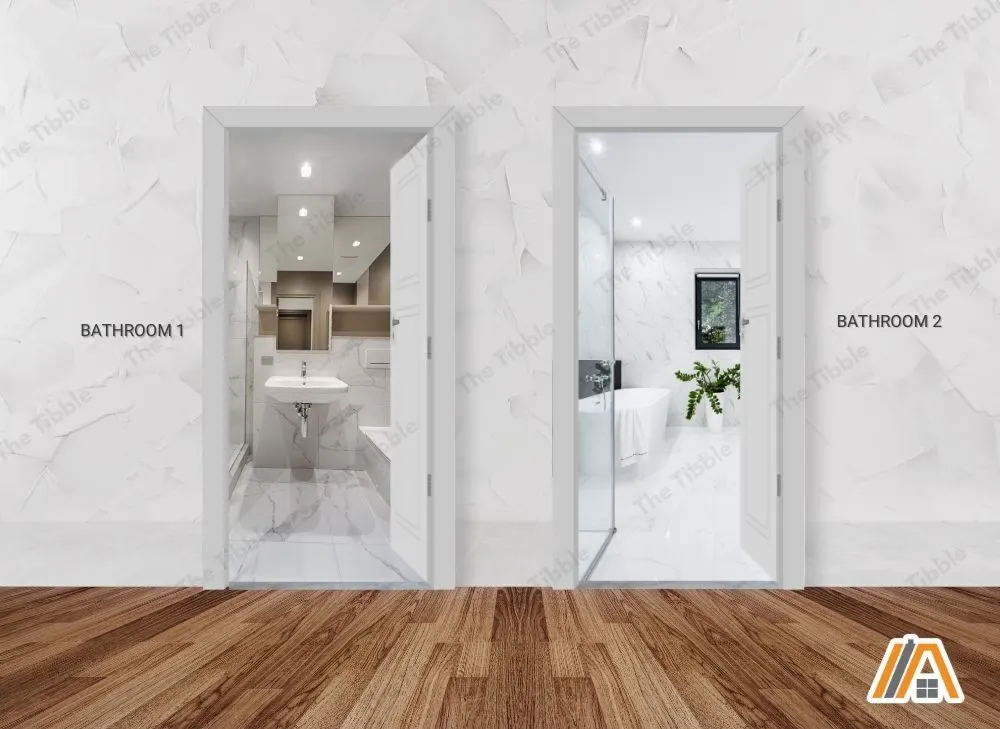
Section M1502.2 specifies that a clothes dryer must have an independent ventilation system. Section M1503.3 specifies that domestic exhaust ventilation systems (like range hoods) my have independent ducting.
This means that if it was important for bathrooms, the code would have definitely stated it explicitly.
Let’s look again at the California Mechanical Code 2022, specifically regulation 510.1.2. This states:
“Duct systems shall not be interconnected with any other building ventilation or exhaust system.”
As you can see, it is important to check your local codes for the final say, but most states adopt the mechanical ventilation section of the IRC without major changes, so we will proceed following the IRC.
Two Fans
The first method of shared ducting between two bathroom exhaust systems is to install a fan in each bathroom and get each to lead into a common duct, which takes the air out through a common external vent.
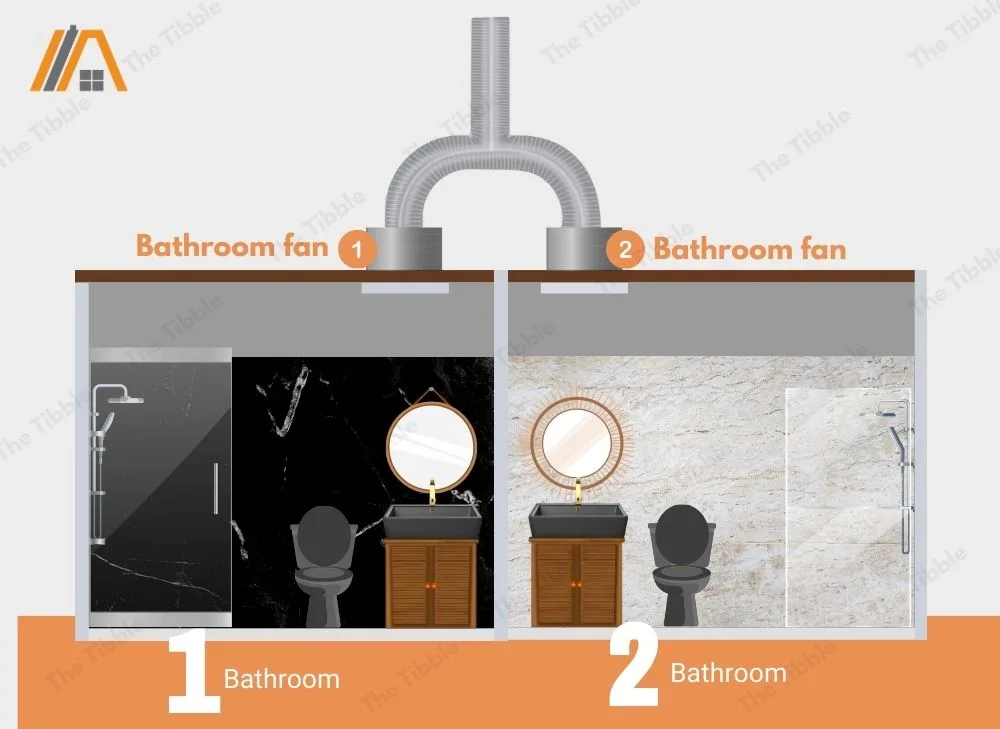
Pros:
- Each bathroom fan can be operated indivdually.
- Separate fans can often mean more effective exhausting of steam.
Cons:
- You will have the cost of two fans (purchase, maintenance, repair, and running).
One Inline Fan
The second method that you can use is to install a single fan in the common part of the duct. This fan will serve both bathrooms and all you will have in the ceiling/wall of each bathroom is a grille over an open duct.
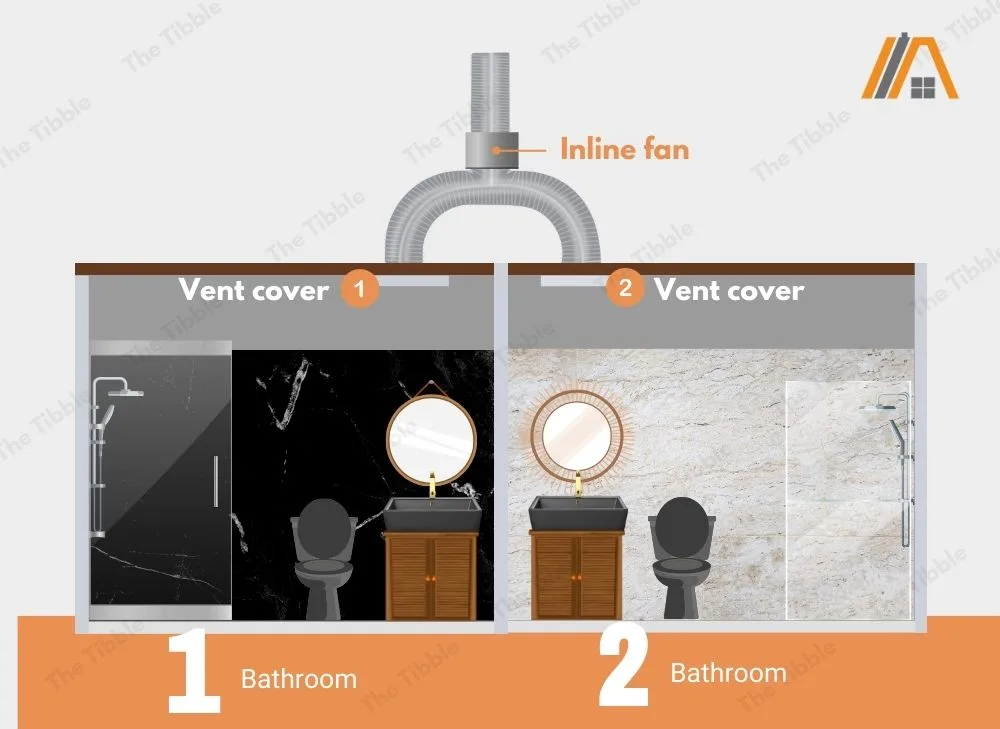
Pros:
- With the fan further away from each bathroom, there is less of a noise created in the bathrooms.
- You only have to buy, install, and maintain one fan.
Cons:
- Running costs are not lower with one fan because it turns on when either bathroom is used. The only time it will save electricity is when the bathrooms are used simultaneously.
- Problems with the fan are harder to deal with because it is not conveniently located in the ceiling or wall. You will have to access and open the ducts.
There are kits available with inline fan and vent covers.
- EXHAUST FAN KIT: Kit includes components to install a single exhaust system using a 6-inch duct fan, two grilles, two sleeves with dampers and duct clamps, and a 3-way 6-inch U adapter for an easy...
- EFFICIENT: Operates on 250 CFM and 0.6 Amps to ensure a high-quality, quiet performance every use in rooms up to 215 sq. ft.
- GREAT FOR LARGE SPACES: This housing can be installed in the attic or basement - wherever is most convenient, making this fan great for large, open spaces
- SAFE: Ventilation fan is ENERGY STAR Certified for quality you can rely on during day-to-day use
Last update on 2024-03-27 / Affiliate links / Images from Amazon Product Advertising API
While convenient, you may be able to save a little money by buying individual parts. You might also have to upgrade the backdraft damper that comes with the kit as these are often of lower quality.
Here are the individual parts that I recommend:
| Product | Amazon link |
| Inline Fan 295 CFM | View |
| Y duct 6 by 4 by 4 inch | View |
| Air Vent Cover | View |
| Damper | View |
The items included are sized for two average-sized bathrooms.
Factors to Consider Before Connecting the Fan Ducts
Manufacturer Instructions
If the manufacturer says to provide an independent exhaust system for their fan, then I would suggest you seriously consider following this recommendation for three main reasons:
- The IRC and local codes often defer to manufacturer instructions, so even if you allowed by code to link two systems, the fact that the manufacturer says not to can weigh against you when it comes time for a building inspection.
- Manufacturer instructions are there to ensure the safest and most effective use of a product. Yes, they are often overly cautious to prevent complaints and lawsuits, but they make the product, so they typically know best when it comes to operating it.
- Going against manufacturer instructions will, the vast majority of times, void your product warranty. So, if anything goes wrong, even if it has nothing to do with connecting the ducts for two fans, the manufacturer can deny your right to the warranty based on the setup.
However, as I stated, the manufacturer is probably just being overcautious and the practice is perfectly fine in most situations. So, if you are happy to risk it, you can give it a try.
Moreover, when it comes to inline fans, the manufacturers would probably prefer you to buy two fans, which could be a motivation behind recommending two separate ducts.
Professional Recommendations
Most professionals say that you shouldn’t link bathroom fans to the same ductwork. Then those that consider it an acceptable practice tend to lean towards the inline fan setup.
I won’t pretend to know better than the people who work with these systems every day and have received proper training in their field, so following their advise is probably the smart thing to do.
However, you can still have final say since it is not a code violation.
And remember, the installers will benefit from the cost of installing two separate systems as opposed to one linked one. I’m not saying that this is their motivation but it is a factor to take into account because it is a savvy business practice.
Duct Sizes
The duct sizes that work with single fans ventilating individual bathrooms are not going to work when two bathrooms are being ventilated, whether with two fans or one inline fan.
The ducts leading from each bathroom to the common duct can be sized normally, but the common duct should be oversized because it must be capable of venting air from two bathrooms simultaneously.
The common duct should be at least one size larger than the individual vents.
So, if your bathroom fans both call for a four-inch duct, then the common ducts should be at least five inches in diameter (although, you might have an easier time getting six-inch ducts).
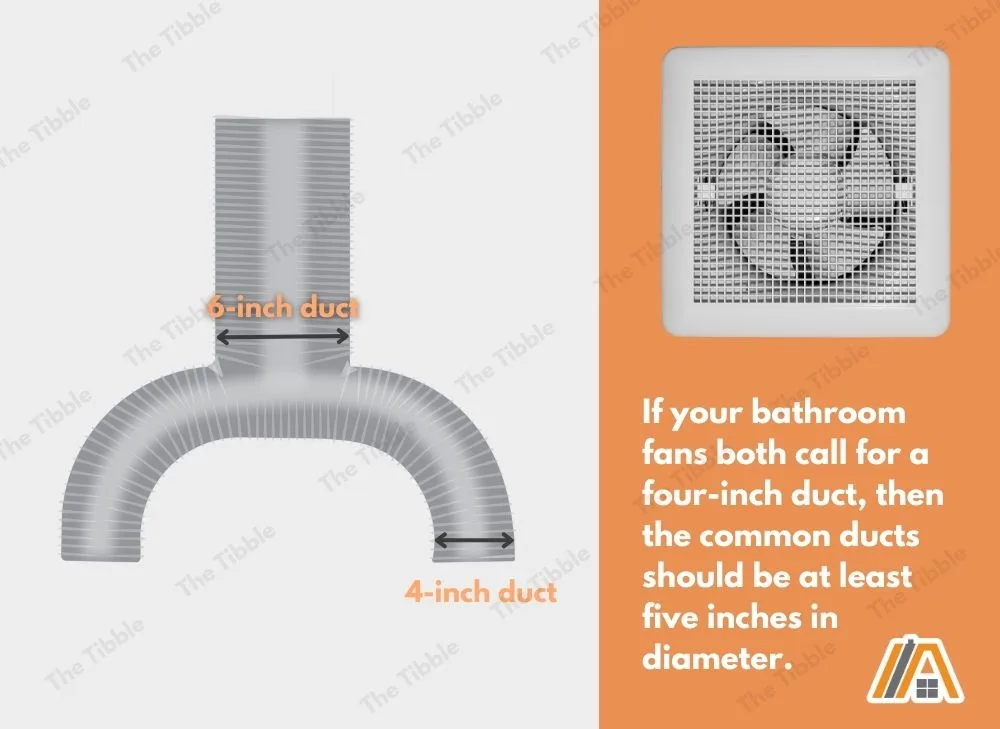
Fan Size
Inline fans have to be capable of exhausting two rooms at once, so it needs to be sized accordingly.
It helps if the bathrooms are also of similar size. If not then the fan could be over-powered for a smaller bathroom resulting in pressure changes that create drafts or pull air out of the drains (basically introducing the need for makeup air).
For the two-fan method, both bathroom fans should be more or less same capacity (even if the bathrooms require very different capacities).
For example, if the first bathroom has a 100 CFM fan installed then the other fan should be 90-110 CFM.
If one of the fans has a much higher capacity, then there is a chance of air moving from one bathroom to another instead of into the common duct and out through the common vent.
Again, it helps if the bathrooms are of similar size to match the similarly sized fans. Otherwise, one fan will be oversized and cause issues with airflow in that bathroom.
Because of these issues, I would say that if you are looking to vent a full bathroom and a small powder room, you should just go with separate ventilation systems.
Backdraft Damper Inclusion and Placement
Backdraft dampers are not required by code but they are incredibly helpful to any ventilation system. When it comes to shared ductwork, they are vital.
A backdraft damper will stop air from one bathroom being pulled or passively moving into the other.
In order to avoid this, the best placement for a backdraft damper is at the point where the individual vents connect to the common vent, regardless of if the two-fan or the one-fan method is employed.
I would then recommend another backdraft damper somewhere near the terminal common vent to prevent backflow of exhausted air into the system and to prevent outside air from entering.
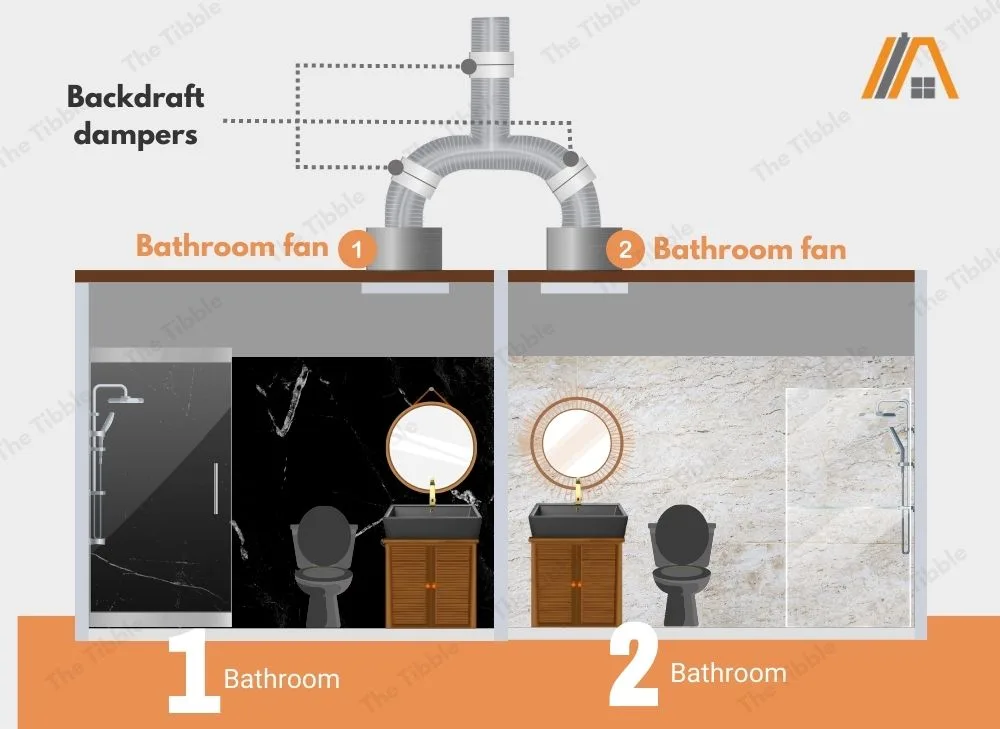
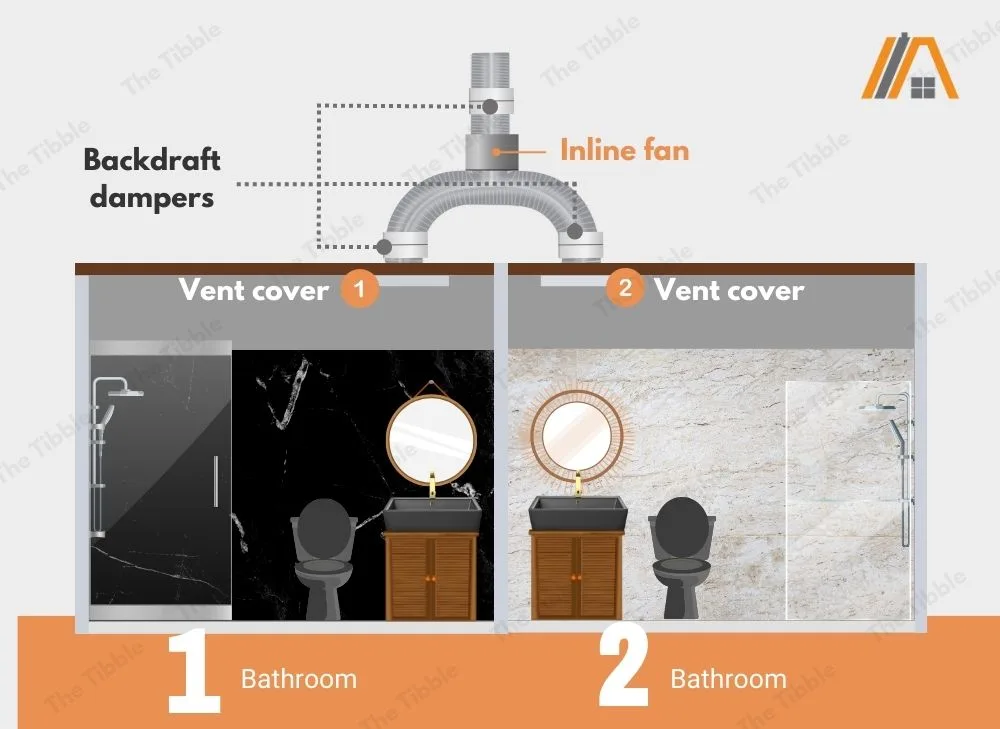
Some bathroom fans come with a damper installed, but if yours lacks a damper make sure to install one. I recommend spring-loaded dampers by AC infinity (amazon link). AC infinity dampers are very airtight and can be installed both horizontally and vertically.
Spring-loaded dampers are quiet when it is windy outside. A gravity-operated damper can start flapping when it is very windy outside. So, this is also something to consider when choosing a damper.
When it comes to shared ducts, when something goes wrong, it affects both bathrooms.
An air leak will make both bathrooms less effectively ventilated and may cause dripping from the fans or vent covers.
Similarly blockages in the common ducts will affect both bathrooms.
Repairs will put both bathrooms out of order until they are completed.
I could list plenty more examples, but you get the idea.

